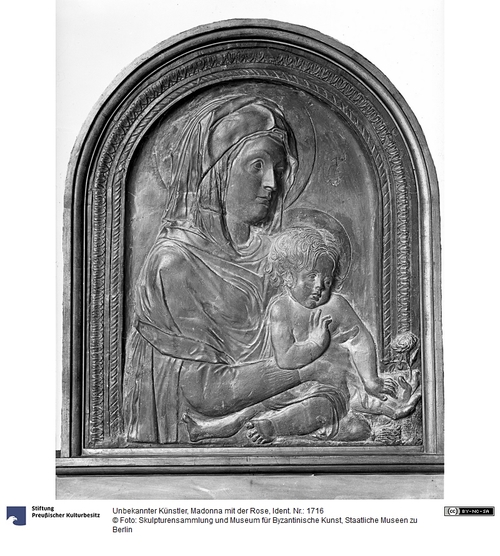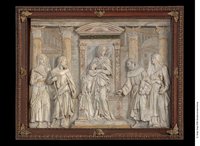Florentine artist
Virgin and Child, known as the Madonna with the Rose
Painted papier-mâché
81 x 65 cm
Berlin, Staatliche Museen, Skulpturensammlung, Inv. SKS 1716.
Bode-Museum, storage.
Provenance
Florence, Stefano Bardini (1890); Berlin, Skulpturensammlung/Altes Museum (1890-1904); Berlin, Skulpturensammlung/Kaiser-Friedrich-Museum (1904-1939); Berlin, storage (1939-1945); Soviet Union, secret storage (1945/46-1958); East Berlin, Skulpturensammlung/Bode-Museum (1958-1990); Berlin, Skulpturensammlung/Bode-Museum (1990-present).
Acquisition
Bought from the dealer Stefano Bardini in Florence in 1890, together with Inv. SKS 1730 and Inv. SKS 1734, for 8,900 Mark (see the acquisition file n°1322/90 in the Zentralarchiv der Staatlichen Museen zu Berlin).
Restorations
1958, 1978-79.
Exhibition
Schätze der Weltkultur von der Sowjetunion gerettet, East Berlin, National-Galerie and Pergamonmuseum, 1958, cat. D 51.
Other Versions
• Bergamo, Accademia Carrara. Provenance: Giovanni Morelli. Photo Kunsthistorisches Institut Florenz: n°49459.
• London, Victoria and Albert Museum, Inv. 8376-1863. Marble, 79.2 x 64.8 cm.
• Florence, villa La Pietra, Acton collection. Painted stucco. Provenance: Stefano Bardini. Photo Kunsthistorisches Institut Florenz: n°224659.
• Formerly Florence, Davanzati Palace. Its sale, 1916, lot 100.
Description
Christ is seated on a cushion, his body twisted between his mother and a hypothetical beholder to the right. The Virgin also looks in this direction, while holding her Child with the right hand and a rose with the other one. Christ reaches for the rose with the left hand, while blessing the viewer with the other. The papier-mâché relief has preserved its polychromy, with a gilt background and an integrated frame with an architectural motif.
In 1890, this relief known as the Madonna with the Rose was bought for the Berlin Museums by Wilhelm Bode from Stefano Bardini in Florence as by the “school of Donatello”. Bode connected the work with a marble relief acquired by the Victoria and Albert Museum in 1863, which he attributed to Donatello himself – somewhat enlarging Donatello’s paternity to the Berlin relief (see Bode 1894). The authenticity of the London marble has been questioned by many art historians (from Balcarres 1903 to Negri Arnoldi 1970). While an inscription with the date 1550 on the reverse has been taken to mean that that relief was created in the 16th century (see Maclagan and Longhurst 1932), the absence of the rose proves that this is not the original model (Pope-Hennessy 1964).
Many things in the composition evoke motifs by Donatello, such as the way the Virgin is seen, cut at the waist to appear closer to the viewer, or the dynamic gestures of the hands or even the blessing gesture of the Child (see the Virgin and Child Inv. SKS 54, but even more a terracotta relief in the Musée du Louvre, Inv. RF 353). However, the quality of the present cartapesta and the marble from London are not sufficient to give these works to Donatello. The name of Andrea Guardi, a minor follower of Donatello in Pisa, has been tentatively suggested by Schottmüller 1933.
Literature
Bode 1894
Wilhelm Bode, Denkmäler der Renaissance-Sculptur Toscanas, Munich, F. Bruckmann, 1894, II, pl. 69: Donatello (caption of the plate).
Bode 1902
Wilhelm Bode, Florentiner Bildhauer der Renaissance, Berlin, Bruno Cassirer, 1902, pp. 102-103, 104 fig. 38: after Donatello; the marble in the Victoria and Albert Museum, London (Inv. 8376-1863) is incorrectly seen as a fake but was made in Donatello’s workshop.
Balcarres 1903
Lord Balcarres, Donatello, London and New York, Duckworth & Co. and Charles Scribner’s Sons, 1903, p. 183: said to be a copy in stucco after a lost original by Donatello; the version in the Victoria and Albert Museum is a forgery. Mentions another version in the Morelli collection, Bergamo.
Schubring 1907
Paul Schubring, Donatello. Des Meisters Werke in 277 Abbildungen, Stuttgart and Leipzig, Deutsche Verlags-Anstalt, 1907, pp. 85, 198: Donatello; connected to the marble in the Victoria and Albert Museum, which is considered a forgery.
Schottmüller 1913
Frida Schottmüller, Die italienischen und spanischen Bildwerke der Renaissance und des Barocks in Marmor, Ton, Holz und Stuck, Berlin, Georg Reimer, 1913, pp. 17-18 cat. 35: after the original by Donatello in the Victoria and Albert Museum, wrongly considered a forgery.
Bode 1921
Wilhelm Bode, Florentiner Bildhauer der Renaissance, Berlin, Bruno Cassirer, 1921, p. 99 fig. 54: Donatello.
Wulff 1922
Oskar Wulff, Donatello, Leipzig, E. A. Seemann, 1922, p. 7, fig. 12.
Colasanti 1931
Arduino Colasanti, Donatello, Rome, Valori Plastici, s. d., pl. CCXL French trans., Paris, Crès, 1931, p. 89, pl. CCXXXV: Donatello, the authenticity of the marble in the Victoria and Albert Museum is problematic.
Maclagan and Longhurst 1932
Eric Maclagan and Margaret H. Longhurst, Catalogue of Italian Sculpture, London, Victoria and Albert Museum, 1932, p. 25: an inscription on the reverse side of the marble in the Victoria and Albert Museum was found, with the date 30 September 1550; this dates the piece.
Schottmüller 1933
Frida Schottmüller, Die italienischen und spanischen Bildwerke der Renaissance und des Barock. Erster Band. Die Bildwerke in Stein, Holz, Ton und Wachs, Zweite Auflage, Berlin and Leipzig, Walter de Gruyter & Co., 1933, p. 20: after Andrea Guardi?; Bode thought the work derived from a terracotta sketch by Donatello; the relief in the Victoria and Albert Museum is probably by Andrea di Francesco Guardi, and the Berlin relief is a derivation from it.
Middeldorf 1938
Ulrich Middeldorf, review of Schottmüller 1933, Rivista d’arte, XX, 1938 now in: idem, Raccolta di scritti that is Collected Writings, I. 1924-1938, Florence, SPES, 1979-80, p. 379: the quality of the work is too high for it to be by Andrea Guardi.
Rezio Buscaroli, L’arte di Donatello, Florence, Monsalvato, 1942, p. 152 cat. 147: mediocre follower of Donatello.
Schätze der Weltkultur… 1958
Schätze der Weltkultur von der Sowjetunion gerettet, exh. cat. (East Berlin, National-Galerie and Pergamonmuseum, 1958), East Berlin, Staatliche Museen zu Berlin, 1958, cat. D 51: after Andrea Guardi.
Pope-Hennessy 1964
John Pope-Hennessy, Catalogue of Italian Sculpture in the Victoria and Albert Museum, London, Her Majesty’s Stationary Office, 1964, I, pp. 97-98: style of Donatello; the absence of a flower in the London version suggests that it was not the prototype for the Berlin version.
Negri Arnoldi 1970
Francesco Negri Arnoldi, “Scultura italiana al Victoria and Albert Museum. II”, Commentari, XXI, 1970, pp. 206-207: forgery.
Restaurierte Kunstwerke… 1980
Restaurierte Kunstwerke in der Deutschen Demokratischen Republik, exh. cat. (Berlin, n. pl., April-June 1980), n. pl. East Berlin, Ministerium für Kultur, 1980, pp. 147-148 cat. 58: restored in 1978-79.
Ehlich 1987
Volker Ehlich, “Naturwissenschaftliche Untersuchungsmethoden. Grundlagen der Restaurierung im Bestand der Skulpturensammlung der Staatlichen Museen zu Berlin”, Neue Museums Kunde, XXX, n°3, 1987, pp. 220-222: about the 1978-79 restoration.
Osservatorio delle arti 1988
Osservatorio delle arti (Rivista semestriale dell’Accademia Carrara di Bergamo), 1988, pp. 28-29: Donatello.
Jolly 1998
Anna Jolly, Madonnas by Donatello and his Circle, Frankfurt am Main et al., Peter Lang, 1998, p. 184 cat. 77.1: circle of Donatello and Michelozzo, ca. 1430s; “the best surviving cast of the series”.
Neville Rowley (20 May 2016)
de

